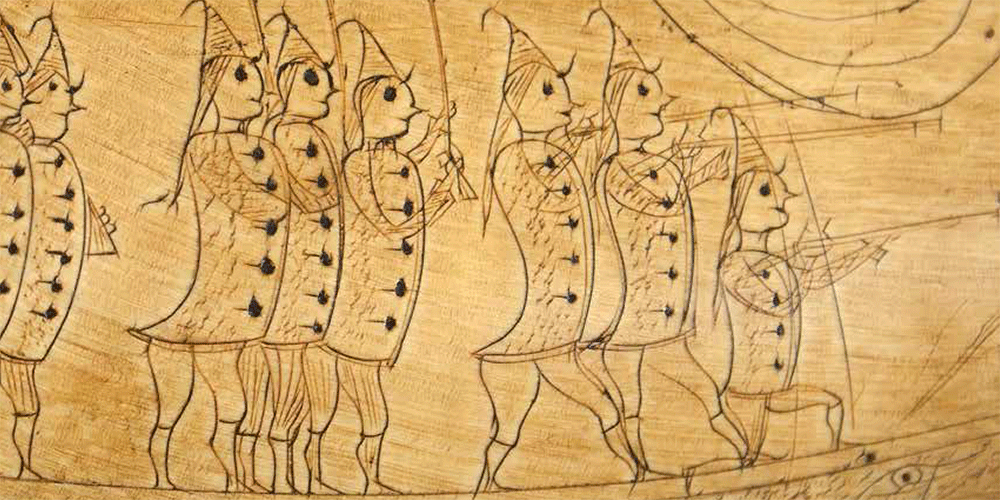This post may contain Amazon Affiliate links for which I may receive compensation.
William H. Guthman, an avid collector of powder horns!
I don’t think you can talk about powder horns without talking about this well-known scholar and dealer in historical and military Americana.
I don’t pretend to know him, but I’d love to show you a few things he has shared with us.
He was born in 1924 and died on December 28, 2005, at the age of 81. He was in the Army Air Force during WWII, worked as a photographer after the war, and then in a manufacturing plant. He finally quit his job to write a book and become a full-time antique dealer, after having bought a box full of post-Revolutionary War letters.
As a collector, he was focusing on artifacts from the periods of the French and Indian War and the American Revolution, work from Native Americans, powder horns, militaria, and prints and documents. He had explained that “It boils down to the fact that I really collect early American history in objects and written words.”
And his collection was simply amazing. His collection was auctioned by Sotheby’s: militia artifacts in January 2003 and manuscript Americana in December 2005.
Additionally, a major auction took place after his death in Portsmouth in October 2006. Sales reached $4.7 million – nothing less! It was a spectacular collection of field drums!
Interestingly enough, the few powder horns in the catalog were not exceptional. The reason is simple. 75 powder horns of his collection were in fact donated to Historic Deerfield and can be seen there. That is definitely where we’ll be heading in a few weeks!
William Guthman was also the author of a few books including “Drums a’beating, trumpets sounding: Artistically carved powder horns in the provincial manner, 1746-1781“ (The Connecticut Historical Society, 1993); New England Militia Uniforms and Accoutrements: A Pictorial Survey (Old Sturbridge Village, 1971); and March to massacre: A history of the first seven years of the United States Army, 1784-1791 (McGraw-Hill, 1975, nominated for a Pulitzer Prize), as well as many articles. (I have to say I cannot wait to see the copy of the first book – signed by the author – which my husband just bought for me!).
He was also an appraiser on the TV show Antiques Roadshow, and thanks to the online video library of the show you can watch some of his appraisals of American powder horns (you can Google PBS Roadshow powder horn appraisal): one appraisal I watched was from 2005, for an 1812 powder horn and a riffle, who belonged to a famous riffle maker, Welcome Mathewson. This combination of his riffle, account book and powder horn was appraised for $100 to 120,000. Quite amazing!
The second one is for a French-Indian War Powder Horn by Spencer Hitchcock Carver (2003), appraised for $40 to 50,000. Like the one discussed in “Engraved Powder Horns – Part 1“, this is another horn with the name of Crown Point and the date of October 1759 engraved on it, but interestingly it also says “Montreal, September 8, 1760”.
I have to say that our expert seems to have missed the incredible significance of this date, as of September 8, 1760, is nothing less than the date when the articles of capitulation of Montreal were signed in the British camp, in front of Montreal.
They were signed by the Governor-General of New France, Pierre-François de Rigaud, Marquis de Vaudreuil-Cavagnal, and the British Major-General Jeffrey Amherst, and mark the defeat of the French against the British and the end of New France, one year after the crucial battle of Quebec City. Sad story!
But this is the reason why these powder horns are great to discover. They often have great historic significance, and tell us the stories of individual soldiers, who lived more than 250 years ago. Truly fascinating.


I have a light yellowish/tan colored power horn and I am trying to find out my family history about it. It has carvings on it and a persons name and place, and a shield on one side inscribed. The persons name is, “J Lumsden” and underneath “Lake Dauphin”, The shield is shapped as to look like maybe early british with top half showing a cross and bottom half comes to a point. Above the shield are two axes crisscrossed and under the shield are leaf branches and a deer head with antlers. There is on one side above the name a 8 pointed star with a circle inside. There are other drawings of design for which I am not sure how to describe. Can you give me any idea as to where I might find out more info or offer it yourself? Thank you for your help.
I’d be happy to post your photos. Just sent you an email.